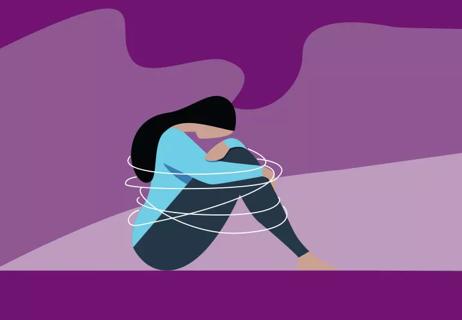Whether this behavior is abusive depends on the person doing it and their motivation

When you were in grade school, you probably learned about oxymorons. They’re figures of speech that bring together contradictory terms. "Organized chaos” is a popular oxymoron, as is “old news.”
Advertisement
Cleveland Clinic is a non-profit academic medical center. Advertising on our site helps support our mission. We do not endorse non-Cleveland Clinic products or services. Policy
Here’s one you hear a lot: “deafening silence.”
If you’ve ever been on the receiving end of the silent treatment, you know how powerful — and even painful — silence can be. But why is that?
We asked psychologist Kia-Rai Prewitt, PhD, to detail the psychology behind the silent treatment. She explains why it’s so upsetting, how to handle it and whether it’s a form of emotional abuse.
Simply put, the silent treatment is the act of withholding communication. It’s a common stonewalling behavior that can be intentional or unintentional. For some people, it’s a coping mechanism. For others, it’s a way of causing harm.
“How can silence be harmful?” you may ask. It has to do with the effect social exclusion has on our bodies and minds.
Research shows that our sympathetic nervous system reacts when we think that a social bond is under threat. Our dorsal anterior cingulate cortex — the region of our brain responsible for processing pain — lights up. Simply put, being ignored or rejected hurts.
Whether that hurt is done on purpose is important, of course, but only to a point. Across the board, the silent treatment is a behavior that indicates poor communication, conflict resolution and emotional regulation skills.
Advertisement
The silent treatment can look different depending on the situation and the person who’s shutting you out. Here are a few reliable indicators that you’re getting the silent treatment:
Another way to know you’re getting the silent treatment: Reflect on your own feelings:
Most of us have given somebody the silent treatment before. So, right about now, you might be wondering: Is the silent treatment an abusive behavior?
Dr. Prewitt says the key to answering this question is looking at the intent behind the action.
Is the person trying to control your behavior or punish you? Are they claiming that their behavior is your fault? That’s abusive, period.
Is the person overwhelmed or deeply hurt? Do they struggle to communicate their thoughts and feelings in general? It’s very possible then, that that individual isn’t trying to harm or coerce you. They’re just struggling with communication and emotional regulation.
“Sometimes, people are so emotionally distressed that they physiologically shut down — they have no other way to respond,” Dr. Prewitt explains. “They can’t even digest the information you’re giving them, let alone verbally give something back. It’s called ‘emotional flooding.’” While it may still be distressing, the lack of intention involved means it doesn’t fall under the rubric of abuse.
For some people, the silent treatment is a learned behavior — one they might not even realize is wrong. In fact, they may see it as a good thing, a way to avoid conflict and repress difficult feelings.
“The person may have grown up in a household where the adults shut each other out by not talking to one another for days at a time,” Dr. Prewitt illustrates. “Or maybe that was how someone parented them — if they didn’t do their chores or they got bad grades, the consequence was silence. That type of response comes across as conditional love.”
Advertisement
Growing up with the silent treatment doesn’t excuse it, of course. But it does mean that that individual might not realize how their actions are impacting you — or that there are better ways to handle tough feelings. With the help of a mental health professional, they might be able to learn better ways to cope with stress.
Bottom line: If you’re trying to figure out whether the silent treatment you’re receiving is a form of abuse, that tells you something important about your situation. You may not be in an abusive situation, but it’s not healthy either. Something needs to change.
Because the silent treatment can happen for many reasons — and can be motivated by different goals — it can impact you in a variety of ways. Many people experience frustration (or even anger) that their emotional needs aren’t being met. For some, especially people-pleasers and individuals with a history of trauma, the silent treatment can be frightening.
In other cases, Dr. Prewitt says that the silent treatment can be destabilizing. “It can lead to a lot of confusion and self-doubt. You may question yourself, especially if you don’t know why you’re getting the silent treatment.”
She adds that you may find yourself wondering what you did, or becoming hypervigilant in an attempt to figure out what’s “wrong” with you. Others experience dismay when they realize that they’re accepting unacceptable behavior.
Advertisement
Taking an inventory of your feelings is time well spent. Once you know how you feel about being given the silent treatment, you can decide what to do about it.
So, how do you go about confronting an individual who’s been giving you the silent treatment? Maybe the better question to ask is: Should you confront them? Dr. Prewitt says the answer isn’t straightforward.
“There isn’t a cookie-cutter way to respond to the situation,” she notes. “It depends on the person, why they’re doing it and how safe you feel with them.”
Dr. Prewitt usually asks these questions of her patients:
Answering those questions (on your own or, preferably, in conversation with a mental health provider or loved one) can help you decide how to manage the silent treatment.
Advertisement
The silent treatment isn’t always a sign of a dysfunctional relationship. Sometimes, it’s a sign that an individual needs to work on their communication skills, is overwhelmed with emotion or needs to unlearn a relationship behavior they grew up experiencing.
If you realize that somebody is withholding communication with the goal of manipulating you — and you’re both safe and motivated enough to have a discussion — Dr. Prewitt says assertive communication is an option.
“You can say to the person that you recognize what they’re doing and that it’s not OK,” she explains. “It’s an opportunity to share how their actions are impacting you and outline the behavior you would prefer.”
In an ideal world, that approach will work — and may even enhance the relationship. It’s possible that they’ll respond positively and actively try to make a change.
Of course, we don’t always live in an ideal world. You may get lucky, but it’s also possible that they’ll continue stonewalling you or return to the same destructive behavior over and over again.
“If you recognize that this person isn’t going to make any changes, you have to decide for yourself if you want to be the one that makes a change,” Dr. Prewitt states. “And making that change may mean deciding you don’t want to be a part of that relationship anymore.”
If the silent treatment is part of a larger pattern of abuse — be it verbal, physical or psychological — Dr. Prewitt advises calling, texting or visiting the National Domestic Violence Hotline website. They have many tools to help you:
There’s also a whole section of the website dedicated to helping concerned loved ones understand and provide support for someone experiencing domestic violence.
Dr. Prewitt is quick to note that leaving an abusive relationship or confronting an abusive partner can be dangerous. So, if you have any concerns about your safety, reach out to somebody and ask for help.
Chances are you’ve been on both sides of the silent treatment at different points in your life. But what should you do if, more often than not, you’re the one giving people the silent treatment? Is it possible to change?
First things first: Don’t beat yourself up. If you’re recognizing that your conflict resolution and communication skills need work, you’re already making progress! If you’re ready to make a change, Dr. Prewitt has some advice.
The silent treatment is the practice of withholding communication from a person during a conflict. Individuals with abusive tendencies sometimes use the silent treatment as a tool to shame, punish or manipulate. Individuals who don’t intend to cause harm sometimes resort to the practice when they’re overwhelmed, unable to cope with conflict or struggle to communicate painful feelings.
How you handle the silent treatment depends on who’s doing it and why. If you’re giving somebody the silent treatment, consider getting mental health support to work on your conflict resolution and communication skills.
Learn more about our editorial process.
Advertisement

This form of psychological and emotional abuse is often disguised as excessive flattery

Regain your footing so you can move forward

Connecting with others, going for a walk or focusing on sleep quality can help more than you might realize

Like being your own best friend in times of trouble, self-love is an act of self-preservation

It’s not about embracing your dark side — it’s about showing up for yourself

Like a boring ol’ grey rock, the goal is to be unresponsive and uninteresting to dissuade a harmful situation

Narcissistic personality disorder is a mental health condition, not an insult

Presenting yourself differently in different contexts can be both empowering and isolating

Type 2 diabetes isn’t inevitable with these dietary changes

Applying a hot or cold compress can help with pain